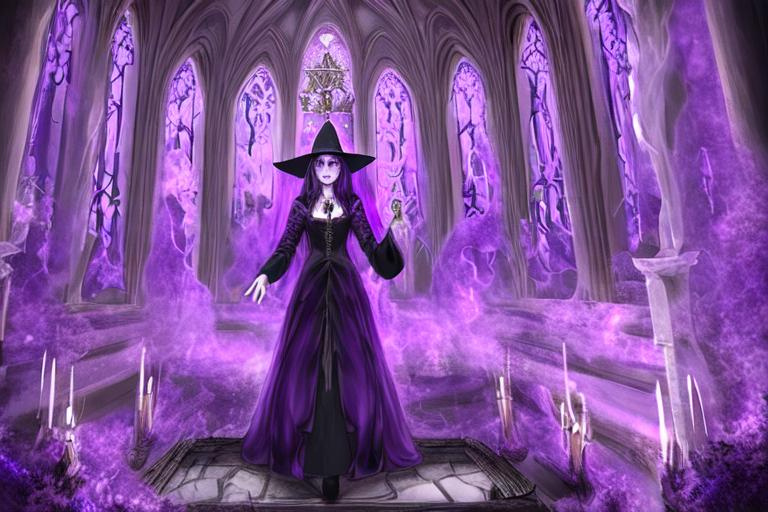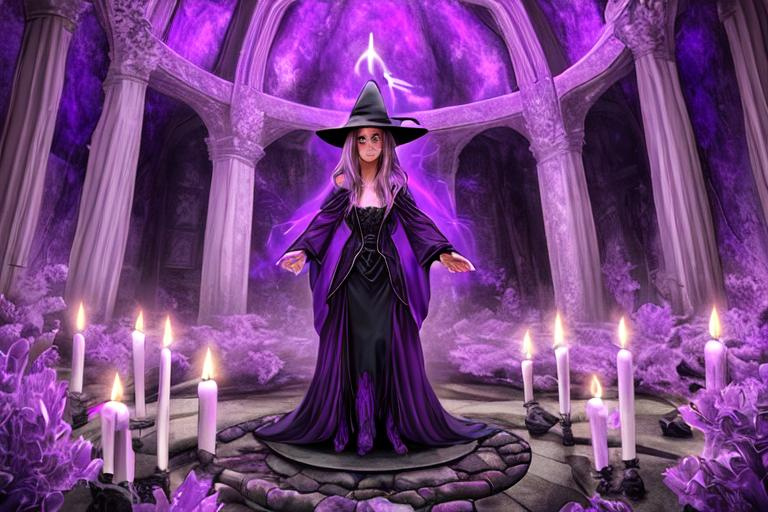
As a practitioner of witchcraft, I have come to appreciate the value of having a dedicated space that is deemed sacred, where I can conduct my magical workings. This space is not just a physical location, but a spiritual and energetic one as well. It is a place where we can connect with the divine, harness our personal power, and create change in the world around us.
The concept of a sacred space is central to many forms of witchcraft and pagan spirituality. In Wicca, for example, practitioners often create a “circle” using salt, stones, or other materials to demarcate the boundary of their ritual space. This circle is a physical representation of the energetic boundary that separates the mundane world from the spiritual realm in which the magic takes place.
The purpose of the sacred space is not just to provide a physical location for the ritual, but to create a container for the energy that we are working with. This energy can come from a variety of sources, such as the elements, spirits, ancestors, or deities. By creating a space that is energetically pure and protected, we are able to more effectively direct and manipulate this energy to achieve our desired outcomes.
The specific location of a witch’s sacred space can vary widely depending on the individual’s needs and preferences. Some witches prefer to work outdoors, in a secluded grove or natural setting. Others may create an indoor altar or ritual space in their home, adorned with candles, crystals, and other symbolic items. Still others may simply visualize the sacred space in their minds, using their imagination and intention to create a powerful energetic container.
Regardless of the physical location, the sacred space should be set up in a way that feels safe and comfortable for the practitioner. This may involve cleansing the space with herbs, incense, or other purifying agents, or using protective symbols and amulets to ward off negative energy. It is also important to create an intentional space that reflects the practitioner’s personal beliefs and values, incorporating items that hold personal meaning and significance.
One of the most important aspects of creating a sacred space is the act of grounding and centering. This involves connecting with the earth and drawing on its energy to help us feel grounded and stable. This can be done through visualization, meditation, or physical exercises such as yoga or walking barefoot on the earth. By grounding ourselves, we are able to better connect with the energy of the sacred space and the magic we are working with.
Another important aspect of the sacred space is the altar. This is a physical space where the practitioner can place items that are sacred to them, such as candles, crystals, statues, or other symbols of the divine. The altar is a focal point for the practitioner’s attention and intention, and is used to help them connect with the energy of the sacred space and the spirits they are working with.
The use of symbols and correspondences is also important in creating a powerful sacred space. Each item on the altar or within the space should hold personal significance and be chosen with intention. For example, a practitioner may choose to use a green candle to represent abundance, a piece of rose quartz to symbolize love and compassion, or a feather to represent the element of air.
The creation of a sacred space is a deeply personal and individual process, and there is no one “right” way to do it. It is important to listen to your intuition and trust your own inner guidance when creating your sacred space. This may involve experimenting with different tools and techniques, and making adjustments as you go along.
Ultimately, the sacred space is a place of transformation and magic, where we are able to connect with our higher selves and the divine. It is a place where we can work towards our goals and desires, and create positive change in the world around us. By taking the time to create a powerful and intentional sacred space, we are able to tap into our inner power and bring about the change that we seek.
In addition to the physical and energetic aspects of the sacred space, it is also important to consider the psychological and emotional impact of the space. Many witches find that the act of creating a sacred space can be a deeply healing and transformative process, helping them to release negative energy and emotions and connect with their true selves.
For some, the sacred space may also serve as a refuge from the stresses and pressures of daily life. In a world that can often feel chaotic and overwhelming, the sacred space can be a place of peace, calm, and rejuvenation.
Of course, the sacred space is not just a place for solitary practice. For many witches, it is also a place to gather with others in ritual and celebration. In a coven or other group setting, the sacred space serves as a container for the collective energy of the group, allowing them to work together towards a common goal.
When working in a group setting, it is important to create a shared understanding of the purpose and intention of the sacred space. This may involve setting guidelines for behavior and conduct, or agreeing on specific rituals and practices to be used within the space.
Regardless of whether you are practicing alone or with a group, the creation of a sacred space is an important part of the witch’s journey. It is a way to connect with the divine, tap into our inner power, and create positive change in the world. By taking the time to create a powerful and intentional sacred space, we are able to fully embrace the magic of the universe and manifest our desires into reality.
I would like to offer a word of encouragement to my fellow witches. Whether you are just starting out on your path or have been practicing for years, remember that your sacred space is a reflection of your own inner power and intention. Trust yourself, listen to your intuition, and allow the magic to unfold. May your sacred space be a place of transformation, healing, and divine connection.
Selecting the Perfect Location for Your Sacred Space

As witches, we know that creating a sacred space is essential to our spiritual practice. A sacred space is a physical representation of our inner world, and serves as a portal for connecting with the energies of the universe. It is a place where we can go to seek solace, receive guidance, and deepen our connection to the divine.
Choosing the right location for your sacred space is an important first step in setting up your altar. When selecting a location, it’s important to consider the energy of the space and how it aligns with your intentions. Ideally, you want a location that feels peaceful, protected, and conducive to your spiritual practice.
One option for setting up a sacred space is to create a dedicated room or space in your home. This could be a spare room, a nook in your bedroom, or even a closet. If you have the luxury of a dedicated space, take the time to clear out any clutter and make the space your own. Consider painting the walls a calming color, hanging curtains or tapestries, and adding comfortable seating or floor cushions.
If you don’t have a separate room for your sacred space, don’t worry. You can still create a beautiful and meaningful altar in a corner of your bedroom or living space. Choose a spot that feels cozy and protected, and use furniture or dividers to create a sense of privacy and separation from the rest of the room.
Another option for setting up a sacred space is to create an outdoor altar or shrine. This could be a corner of your garden, a tree stump in the woods, or any other natural space that speaks to you. Consider using natural materials such as stones, wood, or shells to create your altar, and incorporate elements of the natural world such as plants, flowers, or water.
When choosing a location for your sacred space, it’s important to consider any practicalities such as access to natural light, ventilation, and temperature control. You also want to ensure that the space is safe and secure, and won’t be disturbed by pets, children, or other distractions.
Remember, your sacred space is a reflection of your inner world, and should be a place where you feel comfortable and connected to your spiritual practice. Whether you choose to create a dedicated room, a corner of your bedroom, or an outdoor altar, make sure that the space reflects your unique energy and intentions. With a little creativity and intention, you can create a sacred space that supports
Creating Your Sacred Space: A Witch’s Guide to Setting Up an Altar

As practitioners of witchcraft, we understand that our sacred space serves as a potent instrument for channeling our energy and bringing our intentions to fruition. But how exactly do we go about creating this space? In this guide, I’ll walk you through the process of setting up your sacred space, including how to create an altar that reflects your personal intention and energy.
Your sacred space may comprise of anything that resonates to you, this could be crystals, stones, music, oil essences, incense, water features or statues of gods and goddesses, the atmospheric conditions on any given day is all important and will set the tone of your ritual. Each time you enter your sacred space you will have a different experience, you are aiming for spiritual melding. When performing a ritual within your sacred space, adopt a pattern of behavior and follow this each time you are in your spiritual space, this way your habit or pattern can become an integral part of the psyche.
Everything contained in your sacred space should have some symbolism and resonance of energy, this will help create a powerful vibration for you to work with, everything should have a meaning. Your sacred space is a place of spiritual growth and advancement, somewhere you can work alone or with others, you want a space that induces spiritual states and engenders self-attunement. When inviting others into your sacred space they are required to surrender to the moment with concentrated consciousness, every bit of attention should be focused on direction from spiritual dimensions. The best people to work with are like minded souls as they help to raise the energies, when working as a group each entity becomes part of the whole, much like an orchestra, although just one person can produce the required energy for a precise meditation. The reason for a sacred space is to create a connection between divinity and physical being.
To begin, the physical being meditates in their sacred space in order to make contact with a deity, begin by dimming lights or lighting candles, you can chant and focus on your breathing. Words are very important when attempting spiritual connection, whether they be used soundlessly or chanted aloud, intonation is important as this helps to evoke a response from higher entities. Soul responses are obtained from emotional levels with the use of chants, bells, physical symbols, scents, colours and sounds, such as spiritual meditation music. Your spiritual consciousness allows the mind, body and spirit to form a unity. Deep meditation is different for every single person, much like looking at a kaleidoscope, each person will adjust to what appeals to them. Within your sacred space, body, mind and spirit are held together through focus, you are in your special space doing something special.
Ever since the beginnings of sacred space activities, each participant enters with a feeling of hope and faith that they will be able to make contact with the higher realms, and receive Divine guidance. Terminology may have changed over the centuries but the overall belief system has stayed the same. Within your sacred space you can create an atmosphere that favours spiritual attainment and self-development, your sacred space is there to help you learn and evolve. Within your sacred space, bad habits can be inhibited and good habits enhanced. Within your sacred space there is room for every class and type of human temperament to grow spiritually, if they are willing. Some sacred space dwellers run a closed shop and will only admit those they feel are spiritually enlightened, while others offer an open invitation to all types. Then again a single person can create a sacred space suitable to them and their particular needs, and they may if they choose, invite others who are similarly aligned into their sacred space. Those who favour group activity often find they are psychically drawn to the right people for their needs, within this group they find harmonious and satisfying spiritual relationships through an energy exchange.
A person’s sacred space need not be a physical one, as in essence it is the individual’s consciousness connecting to a state of spiritual being. Connecting with the Divine can be a personal one, a private one with a few close individuals, or a more public one consisting of many people. The personal one is a ritual with a single soul, the private connection is restricted to a few friends and/or family, the public gathering is larger and not necessarily familial and close friends, it is for like minded individuals, it is all inclusive. Whatever type of sacred space, contemplation takes place and the energy is benign. All in all the more people in the world who connect to the Divine, the higher the vibration of the cosmic consciousness. The gathering of spiritual beings contribute to the world thought currents, which over time bring about spiritual changes. With concerted consciousness and focus, we can go far beyond what we deem to be our limits. There is no limit to what coordinating consciousness can achieve. Sacred space activity is for those who believe in a higher power and want to reach and commune with this power for their spiritual advancement. Thoughts that dart around the cosmos like radio waves, become audible sounds that sensitives can tune into, the more spiritually enlightened we become, the more hospitable the earth plane becomes. By becoming more open and sensitive to spiritual energies, the easier it is to commune with finer and more uplifting frequencies.
Building a sacred space begins with a thought, you are clearing a space of consciousness so that spiritual energies can be contacted, this is how you prepare yourself for a connection with higher realms. Meditation within your sacred space gives the mind chance to rest while the soul replenishes. When you are in your sacred space you switch on to higher frequencies, this is intention so that you can tune into the cosmos, when you have finished you switch off. Once you become fully disciplined in this art you will find it very easy to switch on and off, and you will feel fulfilled after the experience. Your sacred space, as well as being a place of esoteric expression, becomes your training ground for enlightenment, over time you become conditioned as meditation uplifts the mind and soul. Your Temple can become a place of transcendental fulfillment and afford you the opportunity to develop inner qualities. The most important sacred space you will ever be within is the one inside your head, which is your own cosmos of consciousness, and which can over time, become the most elaborate sacred space you will ever enter. Your sacred space is a location in space and time where higher elements are tapped.
Should you decide to have a physical sacred space and wish to invite others to commune with you, choose these individuals carefully as one person’s energy affects another’s. Once you decide to work with others create a routine, through this you will find that each time you meet and meditate the vibrations become more intense, this is a situation where habit is a good thing. As a sacred space dweller, whatever you decide to do, make sure that you feel entirely comfortable with your choice. When you meditate in your sacred space, you are attempting to enhance your state of being as you appeal to a higher power, you are attempting to commune with a higher entity for self-betterment. When in your sacred space you are combining life principles with spiritual powers and you are making an impact on Cosmic Consciousness.
Step 1: Choose a Space
The first step in setting up your sacred space is to choose a physical location for it. This may be a dedicated room in your home, a corner of a room, or even a small outdoor space. It’s important to choose a space that feels comfortable and safe, and that you can dedicate specifically to your spiritual practice.
Step 2: Cleanse the Space
Once you’ve chosen your space, it’s important to cleanse it energetically. This can be done using a variety of methods, such as burning sage or palo santo, sprinkling salt or holy water, or playing music or chanting. The goal is to remove any negative or stagnant energy from the space, and create a clean slate for your practice.
Step 3: Set Your Intention
Before you begin setting up your altar or other tools, take a moment to set your intention for the space. What do you hope to achieve in this space? What energy do you want to cultivate? This intention will guide you as you make decisions about what to include in your sacred space.
Step 4: Choose Your Altar
The altar is the central focus of your sacred space, and it’s important to choose one that reflects your personal intention and energy. This may be a table, shelf, or other surface, and it can be as simple or elaborate as you like. Some witches choose to decorate their altar with crystals, candles, statues, and other symbols of their practice.
Step 5: Choose Your Tools
In addition to your altar, you may want to include other tools in your sacred space. These might include a wand, athame, chalice, cauldron, or other items that are meaningful to you. It’s important to choose tools that resonate with your personal energy and intention, rather than simply following tradition or what others may use.
Step 6: Arrange Your Altar
Once you’ve chosen your altar and tools, it’s time to arrange them in a way that feels visually pleasing and energetically balanced. Some witches prefer a symmetrical arrangement, while others like to create a more organic and free-flowing layout. Experiment with different arrangements until you find one that feels right for you.
Step 7: Add Decorative Touches
To really make your sacred space your own, you may want to add decorative touches such as candles, flowers, or other items that reflect your personal style and intention. Just be sure that these items don’t detract from the energy of the space, and that they enhance your practice rather than distracting from it.
Step 8: Use Your Sacred Space
Once you’ve set up your sacred space, it’s important to use it regularly. This might involve daily meditation, ritual work, or simply spending time in the space connecting with your inner self. The more you use your sacred space, the more powerful it will become.
Setting up your sacred space and altar is a deeply personal process that requires intention, intuition, and creativity. By following these steps, you can create a space that reflects your unique energy and intention, and that serves as a powerful tool for harnessing your inner power and manifesting your desires. May your sacred space be a place of transformation, healing, and divine connection.
Magical Tools and Symbols

In magical practices, a variety of tools and symbols are often utilized. These objects are imbued with energy and symbolism, and can serve as powerful conduits for connecting with the energies of the universe.
When setting up your sacred space, consider incorporating some of these tools and symbols to enhance your practice. Some common magical tools include candles, crystals, herbs, tarot cards, and wands.
Candles are a popular tool for setting the mood and creating a sacred atmosphere. They can also be used to represent the four elements – earth, air, fire, and water – and can be placed in specific locations on your altar to correspond with each element.
Crystals are another powerful tool for witches, and can be used for a variety of purposes such as healing, protection, and manifestation. Each crystal has its own unique energy and properties, so be sure to choose crystals that align with your intentions.
Herbs are also a popular tool for witches, and can be used for everything from healing to protection to divination. Consider incorporating dried herbs or fresh plants into your altar, or creating a small herb garden in a nearby window or outdoor space.
Tarot cards are a popular tool for divination and can be used to gain insight and guidance on your spiritual journey. Choose a deck that speaks to you and incorporate it into your practice by pulling cards for guidance or using them in rituals.
Wands are another powerful tool for witches, and can be used to channel energy and cast spells. You can purchase a wand or create your own using materials such as wood, crystals, or feathers.
In addition to these tools, there are also a variety of symbols that hold significance for witches. These symbols can be incorporated into your altar to enhance your practice and deepen your connection to the universe.
Some common symbols include the pentacle, which represents the five elements and is often used for protection and manifestation. The triquetra is another powerful symbol that represents the interconnectedness of mind, body, and spirit.
Other symbols commonly used in witchcraft include the moon, which represents the feminine energy and cycles of nature, and the sun, which represents masculine energy and vitality.
When incorporating magical tools and symbols into your practice, be sure to choose objects that resonate with your personal energy and intentions. Take the time to infuse them with your own energy and intention, and use them to deepen your connection to the universe and enhance your spiritual practice.
Symbols and their magical strengths or purposes:
Pentacle – protection, banishing negative energy, attracting positive energy
Moon – intuition, feminine power, psychic abilities
Sun – masculine power, success, confidence
Hamsa – warding off evil, protection, blessing
Triquetra – unity of the threefold nature of the divine, protection, balancing energy
Ankh – life, vitality, healing, transformation
Tree of Life – connection to the earth and the divine, growth, rebirth
Eye of Horus – protection, healing, intuition, insight
Runes – divination, communication with spirits, manifestation
Ouroboros – eternal cycle of life and death, transformation, infinity
Chakra symbols – balancing and aligning energy centers in the body
Sigils – creating and manifesting desires, protection, banishing negative energy
Triangles – balance, manifestation, representing the three aspects of the divine
Lotus flower – spiritual awakening, purity, divine potential
Spiral – journey of life, growth, expansion
Feather – communication with spirits, manifestation, freedom
Angel – divine guidance, protection, healing
Scarab beetle – resurrection, transformation, protection
Celtic knots – unity, interconnectedness, protection
Infinity symbol – eternal love, balance, abundance, and limitlessness.
Maintaining Your Sacred Space

Once you have created your sacred space and incorporated magical tools and symbols into your practice, it is important to maintain the energy of your space to ensure that it remains a powerful tool for spiritual connection and manifestation.
One important aspect of maintaining your sacred space is keeping it clean and clutter-free. Regularly dusting your altar and removing any items that no longer serve a purpose can help to keep the energy flowing and prevent stagnation.
Another important aspect of maintaining your sacred space is setting intentions and regularly renewing your connection to the universe. This can be done through meditation, ritual, or simply taking a few moments each day to connect with your space and set your intentions for the day.
It is also important to regularly cleanse your sacred space to remove any negative or stagnant energy that may have accumulated. This can be done through the use of smoke, such as with sage or palo santo, or with sound, such as through the use of a singing bowl or bell.
In addition to these practices, it can also be helpful to periodically rearrange your altar or add new items to keep the energy fresh and flowing. Consider adding seasonal items or incorporating new crystals or herbs that align with your current intentions.
Finally, it is important to remember that your sacred space is a reflection of your inner self, and should be treated with reverence and respect. Take the time to honor your space and the energy that you have infused into it, and use it as a tool to deepen your spiritual practice and manifest your desires.
By maintaining the energy of your sacred space and infusing it with your own personal energy and intention, you can create a powerful tool for spiritual connection and manifestation that will serve you well on your journey.
Honoring Ancestors and Deities

Many practitioners of witchcraft honor and work with their ancestors and deities in their magical practice. Incorporating this practice into your sacred space can deepen your spiritual connection and provide guidance and support on your journey.
To honor your ancestors, consider creating a space on your altar or within your sacred space that is dedicated to them. This can include items that represent your lineage, such as photos or heirlooms, as well as offerings such as food or drink that they may have enjoyed in life. Lighting a candle or incense in their honor can also be a powerful way to connect with their energy and seek their guidance and support.
Working with deities is another common practice in witchcraft, and can be incorporated into your sacred space through the use of statues, symbols, or offerings that represent the deity or deities you work with. Take the time to research the mythology and correspondences of the deity, and choose items that align with their energy and purpose. Lighting candles or incense in their honor and reciting prayers or invocations can also deepen your connection and invite their presence into your space.
It is important to approach working with ancestors and deities with respect and reverence, and to always seek their permission and guidance before incorporating their energy into your practice. Take the time to build a relationship with them, and listen for their guidance and wisdom in your practice.
By incorporating the energy of your ancestors and deities into your sacred space, you can deepen your spiritual connection and invite their guidance and support into your practice. Remember to always approach this practice with respect and reverence, and to listen for their guidance as you work with their energy in your magical practice.
Creating Sacred Space in Group Rituals: Tips for Group Altars and Circle Casting

Many of us as witches engage in practicing our craft within a community of fellow practitioners. Whether it be a coven, a group of friends, or a larger gathering, working together can amplify our energy and create a powerful and transformative experience. When working in a group, creating a sacred space that is inclusive and supportive of all members is essential for the success of the ritual.
One important aspect of creating a sacred space in group rituals is the design and arrangement of the group altar. The group altar serves as a central point of focus and connection for all members of the group, and should reflect the intention and purpose of the ritual. It can include items that represent the elements, deities, or other symbols relevant to the ritual, as well as offerings and objects contributed by each member of the group.
When designing the group altar, it is important to consider the size and layout of the space, as well as the number of participants in the ritual. In larger groups, it may be helpful to have multiple altars arranged in a circle or other formation, allowing for easier access and participation from all members.
Circle casting is another important aspect of creating a sacred space in group rituals. The circle serves as a container for the energy and intention of the ritual, and helps to protect the group from any outside or negative influences. To cast the circle, the group can walk around the perimeter of the space, holding hands or otherwise connecting physically or energetically, and invoking the energy of the elements or deities to create a protective barrier around the space.
As each member of the group casts the circle, they can offer a blessing or intention for the ritual, infusing their energy into the space and connecting with the energy of the group. It is important to establish clear guidelines and boundaries for the circle, including any rules or expectations for participation, as well as a clear opening and closing of the circle to release any energy that has been raised and bring the ritual to a close.
In addition to the group altar and circle casting, there are other tips and considerations for creating a sacred space in group rituals. These include:
- Creating a clear and focused intention for the ritual, and communicating it clearly to all members of the group.
- Assigning roles or tasks to each member of the group, such as calling in the elements or leading a chant, to create a sense of participation and ownership in the ritual.
- Encouraging active participation and engagement from all members of the group, while respecting individual boundaries and limitations.
- Providing a safe and inclusive space for all members of the group, including any accommodations for physical or emotional needs.
- Incorporating music, movement, or other sensory experiences to deepen the connection and engagement with the ritual.
- Providing time and space for personal reflection and processing after the ritual, including any sharing or discussion among the group.
Creating a sacred space in group rituals requires intention, communication, and collaboration among all members of the group. By following these tips and considerations, you can create a safe, supportive, and transformative space for your group to practice magic and connect with one another.
In addition to the physical setup, it’s important to establish guidelines and expectations for behavior during group rituals. This can help maintain a safe and respectful environment for all participants. Before beginning the ritual, the group leader should take time to explain any specific rules or expectations for the group.
Some common guidelines for group rituals include respecting personal boundaries, avoiding interrupting others while they are speaking, and refraining from harmful language or behavior. It’s also important to establish guidelines around consent, particularly when it comes to physical touch or other potentially triggering experiences.
When it comes to group altars, it’s important to consider the space constraints and how the altar can be easily accessed by all members of the group. The altar can be a collaborative effort, with each member bringing an item or symbol that represents their intentions or connection to the group’s theme or purpose.
It’s also important to consider the timing and pacing of the ritual, particularly when working with a larger group. It can be helpful to have a designated person leading the ritual, who can help guide the group through each step and ensure that everyone is on the same page.
When it comes to circle casting, this is typically done as a group effort. The group leader can guide the group through the steps of casting a circle, which involves visualizing a protective barrier around the space and calling upon the elements or other spiritual forces for support.
During the circle casting, it’s important for all members of the group to focus their energy and intention towards creating a safe and sacred space. This can involve speaking words of affirmation or visualization, and can help to establish a strong collective energy that supports the group’s intentions and magical workings.
In group rituals, it’s also important to acknowledge and honor the diversity of beliefs and backgrounds within the group. This can involve incorporating elements of different traditions or belief systems, or simply creating space for individuals to share their own personal practices or beliefs.
Overall, creating a sacred space in group rituals requires intention, collaboration, and a willingness to adapt and adjust based on the needs of the group. By establishing clear guidelines and expectations, working collaboratively on the altar, and focusing on creating a strong collective energy, group rituals can be a powerful and transformative experience for all involved.
Final Musings
As we come to the end of this article on creating a sacred space, I hope that you’ve found some inspiration and guidance for setting up your own personal altar and harnessing your energy for manifestation and transformation.
Remember, your sacred space is a reflection of your inner self, and should be a place where you feel comfortable and connected to your spiritual practice. Whether you choose to adorn your altar with crystals, candles, or other sacred objects, make sure that each item has a special meaning or significance to you.
As witches, we know that the power of manifestation lies within us, and that our sacred space serves as a potent tool for focusing our energy and intentions. Whether you’re seeking abundance, love, protection, or any other desire, your altar can serve as a portal for calling in the energies you wish to manifest.
May your sacred space be a place of sanctuary, transformation, and growth. May it serve as a reminder of your own inner power, and the magic and mystery that lies within you. May you continue to explore and deepen your spiritual practice, and find joy and fulfillment in the journey. Blessed be.




